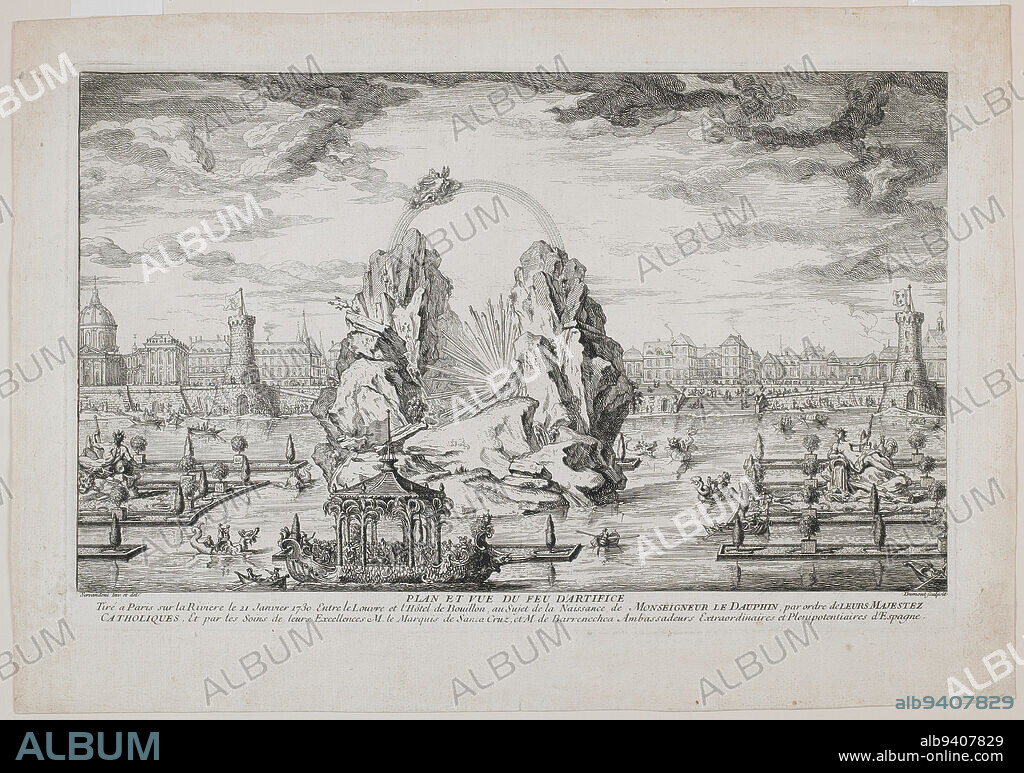alb9407829
Fireworks Dislay in Paris for the Birth of the Dauphin on January 21, 1730, 1730, Jacques Dumont le Romain; Artist: after Giovanni Niccolo Servandoni, French, 1701 - 1781, 12 1/4 x 19 1/4 in. (31.12 x 48.9 cm) (plate)15 1/16 x 21 5/8 in. (38.26 x 54.93 cm) (sheet)23 3/4 x 29 3/4 x 1 1/8 in. (60.33 x 75.57 x 2.86 cm) (outer frame), Etching, France, 18th century, With French governance relying on dynastic succession, the birth of the Dauphin-the male heir to the throne-was cause for celebration. Louis XV's queen, Marie Leszczinska, had given birth to three daughters before having a son on September 4, 1729. In the months that followed, fêtes and fireworks were staged from Paris to Rome. This nautical spectacle was the work of the accomplished architect and stage designer Giovanni Servandoni, who created two fantastical mountains in the middle of the River Seine in Paris, across from the Palais du Louvre, from which to launch fireworks. The fashion for chinoiserie decoration in France is evident in the large pagoda-shaped boat filled with musicians that embarks from the banks of the river, and in the smaller dragon-shaped punts that circle the mountains.

|
Ajouter à une autre Lightbox |
|
Ajouter à une autre Lightbox |



Avez-vous déjà un compte? S'identifier
Vous n'avez pas de compte ? S'inscrire
Acheter cette image.
Sélectionnez l'usage:

Légende:
Voir la traduction automatique
Fireworks Dislay in Paris for the Birth of the Dauphin on January 21, 1730, 1730, Jacques Dumont le Romain; Artist: after Giovanni Niccolo Servandoni, French, 1701 - 1781, 12 1/4 x 19 1/4 in. (31.12 x 48.9 cm) (plate)15 1/16 x 21 5/8 in. (38.26 x 54.93 cm) (sheet)23 3/4 x 29 3/4 x 1 1/8 in. (60.33 x 75.57 x 2.86 cm) (outer frame), Etching, France, 18th century, With French governance relying on dynastic succession, the birth of the Dauphin-the male heir to the throne-was cause for celebration. Louis XV's queen, Marie Leszczinska, had given birth to three daughters before having a son on September 4, 1729. In the months that followed, fêtes and fireworks were staged from Paris to Rome. This nautical spectacle was the work of the accomplished architect and stage designer Giovanni Servandoni, who created two fantastical mountains in the middle of the River Seine in Paris, across from the Palais du Louvre, from which to launch fireworks. The fashion for chinoiserie decoration in France is evident in the large pagoda-shaped boat filled with musicians that embarks from the banks of the river, and in the smaller dragon-shaped punts that circle the mountains.
Personnalités:
Crédit:
Album / quintlox
Autorisations:
Modèle: Non - Propriété: Non
Questions sur les droits?
Questions sur les droits?
Taille de l'image:
5010 x 3522 px | 50.5 MB
Taille d'impression:
42.4 x 29.8 cm | 16.7 x 11.7 in (300 dpi)
Mots clés:
18 18E 18EME XVIII XVIIIE XVIIIEME SIECLE • 18E SIECLE • 18EME S • ARTISTE • ARTISTEL • ARTSTE • ASSIETTE • ASSIETTES • CERCLE • CHAINE DE MONTAGNES • CORDILLÈRE • DIX-HUITIÈME SIÈCLE • FETE, FEU D'ARTIFICE • FEU D'ARTIFICE • FEU: D'ARTIFICE • FEUX D'ARTIFICE • FEUX D?ARTIFICE • FILS NATUREL • FILS • FLUVIALE • FRANÁAIS • FRANÁAISE • FRANCE • FRANÇAIS • GIOVANNI NICCOLO SERVANDONI • MASSIF • MATERNITÉ • MODE • MODE: MASCULINE • MUSICEN • MUSICIEN • MUSICIENS • PARIS • PARIS, FRANCE • PLAT • PLATEAU (VAISSELLE) • ROME • VAISSELLE ASSIETTES • VETEMENT: MODE • XVIIIE SIECLE
 Pinterest
Pinterest Twitter
Twitter Facebook
Facebook Copier le lien
Copier le lien Email
Email
